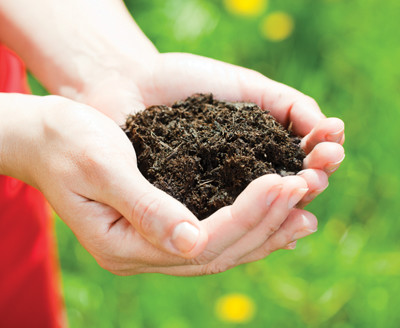Soil, Mulch, Water
Healthy Soil Requires Less Water
4 Steps to Healthy Soil
Step 1. Free the soil!
Healthy plants need soil with good structure. The pore spaces between the solid parts of the soil allow water and air to move freely to the plant’s roots and give plants room to grow. While tilling can cause soil to lose structure and become compacted over time, gentle loosening with a spade, shovel, or gardening fork can open up more pore spaces within compacted soil. Adding compost is also a great way to improve soil structure.
Step 2. Feed the soil!
Compost provides nourishment to soil organisms, which then release nutrients from organic material back into the soil. Synthetic fertilizers don’t feedthe soil; they feed plants. They can actually upset the symbiotic relationships between soil microbes and plants that occur in healthy soil.
Step 3. Moisturize the soil!
A top-dressing of mulch sustains soil moisture. While landscape fabrics may prevent weed invasion, they don’t have the moisture-retaining benefits of mulch. Materials such as coarse wood chips, compost, and even grass clippings are easily-obtainable options for top-dressing.
Step 4. Plant the soil!
Plant with species that are appropriate for their location. Drought-tolerant or native plants consume less water, require less maintenance, and im- prove soil structure more effectively than exotic ornamental plants. Choose plants that need less water!
Organic mulch provides food for many soil organisms. They chew their way through soil layers, creating air and water pockets while decomposing plant litter at the same time – you can kick back while they do the work to provide healthy soil structure in your garden!
Why Compost?
Home composting creates healthy soil for your plants. Healthy soil requires less water. And it only takes a few minutes per week!
Organic waste material, like food scraps and yard cllippings can give new life and a fresh start to your own garden or yard. You can literally turn your leftovers into a landscape. Finished compost is a wonderful soil amendment that improves texture and adds important nutrients into the soil in your garden, creating healthy, thriving plants.
Food scraps (food waste and food-soiled paper) comprise the largest single recyclable item in our landfill, where it does NOT biodegrade, but mummi- fies, creating toxic methane gases. Composting significantly eliminates un- necessary waste and frees up space. You can help reduce waste by com- posting.
Isn’t it hard and time consuming?
Not at all. Once you get started it takes less than ten minutes a week. You can be an Active Composter or a Passive Composter.
What’s the difference between Active and Passive Composter?
Active Composting: With active composting, you actively maintain your system using the “Three-Step Method" described by RecycleSmart. This will produce compost in six months or less.
Passive Composting: With passive composting, you add yard waste and food scraps to your bin or pile and leave it alone to slowly decompose. It's easy to do, but takes a year or longer to generate compost.
Where do I go to learn Composting?
Our page Workshops & Events section lists local workshops.
The Contra Costa Waste Service Recycling Center and Transfer Station donated all the compost and some of the mulch that you see in Living Green Gardens.
You can purchase some for your own garden from the Transfer Station at 1300 Loveridge Road, just north of the Pittsburg- Antioch Highway.
 www.ContraCostaWaste.com
www.ContraCostaWaste.com

Download RecycleSmart’s Home Composting for Busy People brochure. Tons of helpful Information!
Why Mulch?
Mulch sustains soil moisture. Materials such as coarse wood chips, compost, and even grass clippings are easily-obtainable options for top-dressing.
Organic mulch provides food for many soil organisms. They chew their way through soil layers, creating air and water pockets while decomposing plant litter at the same time – you can kick back while they do the work to provide healthy soil structure in your garden!
Mulching Benefits
- Retains moisture
- Reduces weeds
- Improves the quality of your soil
- Insulates plant roots
- Prevents erosion
Common Mulching Materials
- Wood chips
- Shredded bark
- Leaves
- Pine needles/Redwood needles
- Dried grass clippings
Sheet Mulch
Sheet mulching is a simple technique used to enrich the soil in planting areas, lay the foundation for a new garden area, or remove a lawn without using grass-killing chemicals.
It’s a layered mulch system that involves placing a biodegradable weed barrier such as recycled cardboard on bare soil or on top of mowed or flattened weeds or grass. You then place compost and mulch in layers on top of the weed barrier, mimicking the way that layers of leaves build up on forest floors. Trees, shrubs, perennials and annuals can be planted through the sheet mulch, and areas can be left open for existing plants.
Sheet Mulch Now. Ask me how video.
Convert your lawn by sheetmulching.

Download brocuhure: The Benefits of Mulch.



